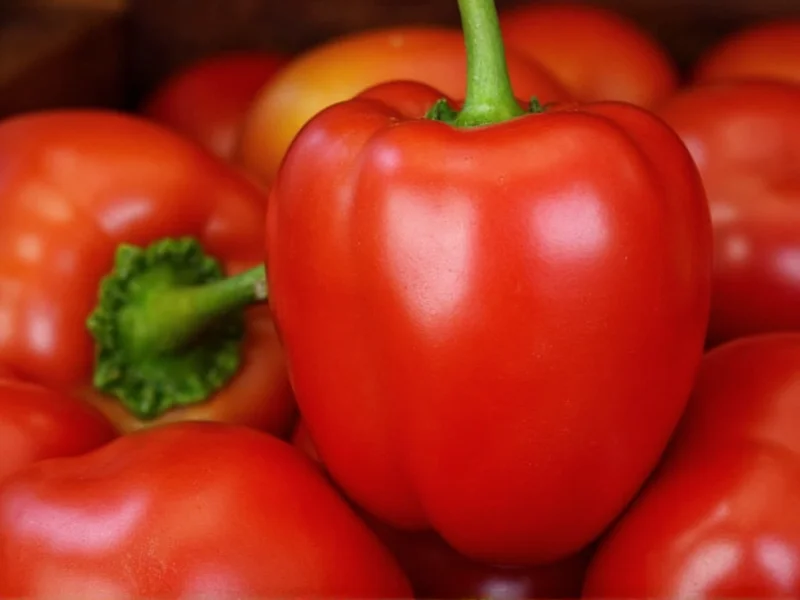Understanding the precise Scoville rating of habanero peppers is essential for both culinary professionals and home cooks. The Scoville scale, developed by pharmacist Wilbur Scoville in 1912, measures capsaicin concentration—the compound responsible for pepper heat—in Scoville Heat Units. While habaneros consistently fall within the 100,000-350,000 SHU range, several factors influence their actual heat level in practice.
What Determines Habanero Pepper Heat Level?
Multiple variables affect where a specific habanero falls within its broad Scoville range:
- Growing conditions: Soil composition, climate, and water availability significantly impact capsaicin production
- Pepper variety: Different habanero cultivars exist, including red, orange, chocolate, and white varieties, each with slightly different heat profiles
- Ripeness: Fully ripe habaneros tend to be hotter than less mature ones
- Plant stress: Mild environmental stress can increase capsaicin production as a defense mechanism
Habanero Scoville Rating Compared to Other Popular Peppers
| Pepper Variety | Scoville Heat Units (SHU) | Heat Relative to Habanero |
|---|---|---|
| Bell Pepper | 0 SHU | 0× |
| Jalapeño | 2,500-8,000 SHU | 1/20th to 1/12th |
| Serrano | 10,000-23,000 SHU | 1/10th to 1/4th |
| Habanero | 100,000-350,000 SHU | 1× |
| Ghost Pepper (Bhut Jolokia) | 800,000-1,041,427 SHU | 2.3-8× |
| Carolina Reaper | 1,400,000-2,200,000 SHU | 4-22× |
Practical Implications of Habanero Heat Measurement
When working with habanero peppers in cooking, understanding their Scoville heat units has several practical implications:
- Precise measurement: Unlike milder peppers, habaneros require exact measurement due to their intense heat variability
- Seeds and membranes: The majority of capsaicin concentrates in the white pith and seeds—removing these can reduce heat by up to 80%
- Delayed reaction: Habanero heat often has a delayed onset (15-45 seconds), which can lead to overconsumption if waiting for the burn
- Culinary applications: Their distinctive fruity flavor profile makes habaneros popular in Caribbean, Yucatecan, and West African cuisines
Safety Considerations When Handling High Scoville Peppers
Due to their significant heat level, proper handling of habanero peppers is crucial:
- Always wear gloves when cutting habaneros to prevent capsaicin transfer to sensitive areas
- Avoid touching your face, especially eyes, while handling these peppers
- Wash hands thoroughly with soap and water after handling, even if you wore gloves
- If experiencing skin irritation, use milk or oil-based products to break down capsaicin (water spreads it)
- For severe mouth burn, dairy products like yogurt or milk provide relief better than water
Why the Wide Range in Habanero Scoville Ratings?
The substantial range (100,000-350,000 SHU) reflects several scientific and practical factors:
- Natural variation: Like any agricultural product, peppers exhibit biological variation
- Testing methodology: Modern HPLC testing provides more precise measurements than the original subjective human taste tests
- Regional differences: Habaneros grown in the Yucatán Peninsula (their origin) often differ in heat from those grown elsewhere
- Cultivar development: Selective breeding has produced habanero varieties with more consistent heat levels
Measuring Pepper Heat: From Subjective to Scientific
The Scoville scale has evolved significantly since its creation:
- Original method (1912): Required human testers to dilute pepper extract until heat was undetectable
- Modern method: Uses HPLC to precisely measure capsaicinoid concentration, then converts to Scoville units mathematically
- Accuracy improvement: HPLC eliminates human subjectivity and provides consistent, replicable results
- Practical impact: Today's Scoville ratings are more reliable, though still reported as ranges due to natural variation
Frequently Asked Questions About Habanero Heat Levels
How does habanero Scoville rating compare to other common peppers?
Habaneros (100,000-350,000 SHU) are approximately 12-40 times hotter than jalapeños (2,500-8,000 SHU) and about 4-10 times hotter than cayenne peppers (30,000-50,000 SHU). They're significantly milder than superhots like the Ghost Pepper (800,000-1,041,427 SHU) or Carolina Reaper (1.4-2.2 million SHU).
Can habanero peppers vary in heat even from the same plant?
Yes, significant variation can occur even among habaneros from the same plant. Factors like sun exposure, water availability, and position on the plant can cause heat differences. One habanero might measure 150,000 SHU while another from the same cluster measures 280,000 SHU.
Why do some habaneros taste fruitier than others?
Habaneros are known for their distinctive fruity, citrus-like flavor profile that complements their heat. Different varieties emphasize different flavor notes—orange habaneros tend to be more citrusy, red habaneros more floral, and chocolate habaneros have earthy, smoky notes. The fruitiness comes from volatile compounds that develop alongside capsaicinoids.
How can I reduce the heat of a habanero in cooking?
To reduce habanero heat: 1) Remove all white pith and seeds (where 80% of capsaicin resides), 2) Soak sliced peppers in vinegar or citrus juice for 15-30 minutes, 3) Cook with dairy products like yogurt or coconut milk which bind to capsaicin, 4) Balance with sweet elements like mango or pineapple which complement habanero's natural fruitiness while reducing perceived heat.
Are there habanero varieties with more consistent Scoville ratings?
Yes, selective breeding has produced habanero varieties with more consistent heat. The 'Habanada' is a rare, naturally occurring mutation that's completely heatless while maintaining habanero flavor. Commercial growers also cultivate specific strains like the 'Red Savina' habanero (once considered the world's hottest pepper at ~577,000 SHU) for more predictable heat levels.











 浙公网安备
33010002000092号
浙公网安备
33010002000092号 浙B2-20120091-4
浙B2-20120091-4